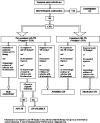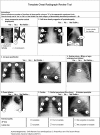Evaluation of tuberculosis diagnostics in children: 1. Proposed clinical case definitions for classification of intrathoracic tuberculosis disease. Consensus from an expert panel
- PMID: 22448023
- PMCID: PMC3334506
- DOI: 10.1093/infdis/jis008
Evaluation of tuberculosis diagnostics in children: 1. Proposed clinical case definitions for classification of intrathoracic tuberculosis disease. Consensus from an expert panel
Abstract
There is a critical need for improved diagnosis of tuberculosis in children, particularly in young children with intrathoracic disease as this represents the most common type of tuberculosis in children and the greatest diagnostic challenge. There is also a need for standardized clinical case definitions for the evaluation of diagnostics in prospective clinical research studies that include children in whom tuberculosis is suspected but not confirmed by culture of Mycobacterium tuberculosis. A panel representing a wide range of expertise and child tuberculosis research experience aimed to develop standardized clinical research case definitions for intrathoracic tuberculosis in children to enable harmonized evaluation of new tuberculosis diagnostic technologies in pediatric populations. Draft definitions and statements were proposed and circulated widely for feedback. An expert panel then considered each of the proposed definitions and statements relating to clinical definitions. Formal group consensus rules were established and consensus was reached for each statement. The definitions presented in this article are intended for use in clinical research to evaluate diagnostic assays and not for individual patient diagnosis or treatment decisions. A complementary article addresses methodological issues to consider for research of diagnostics in children with suspected tuberculosis.
Figures


Comment in
-
Reply to Holm et al.J Infect Dis. 2013 Mar 1;207(5):871-2. doi: 10.1093/infdis/jis769. Epub 2012 Dec 13. J Infect Dis. 2013. PMID: 23242541 No abstract available.
-
Perspectives in implementing standardized case definitions for tuberculosis research involving children in a low-income, high-burden setting.J Infect Dis. 2013 Mar 1;207(5):870-1. doi: 10.1093/infdis/jis768. Epub 2012 Dec 13. J Infect Dis. 2013. PMID: 23242543 No abstract available.
References
-
- Swaminathan S, Rekha B. Pediatric tuberculosis: global overview and challenges. Clin Infect Dis. 2010;50(Suppl 3):S184–94. - PubMed
-
- Graham SM. Research into tuberculosis diagnosis in children. Lancet Infect Dis. 2010;10:581–2. - PubMed
-
- World Health Organization. A research agenda for childhood tuberculosis. Improving the management of childhood tuberculosis within national tuberculosis programmes: research priorities based on a literature review. Geneva, Switzerland: World Health Organization; 2007. WHO/HTM/TB/2007.381.
Publication types
MeSH terms
Substances
Grants and funding
LinkOut - more resources
Full Text Sources
Other Literature Sources
Medical

